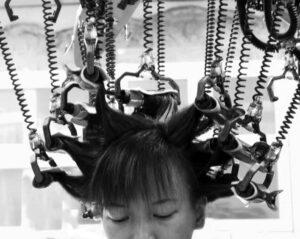Second-hand Material Original Works : Hong Kong

Hong Kong government has recently been reviewing the Copyright Ordinance. Artists who use found footage or images in their works are liable to criminal charges. This situation worries many artists. It can happen in other countries. Therefore this program “Second-hand Material Original Works” will concentrate on this issue, showing derivative experimental shorts. Hong Kong Government makes it clear that “Kuso” style works are infringement of thecopyright law. “Kuso” is popular in some Asian countries. It means Internet users transform or adapt some soap operas, films and TV commercials. The style is always funny and mostly exaggerated. The purposes are always subversive and making fun of the original production. Hong Kong government is always the target of this kind of creation. It seems that the government is using the amended law to combat “Kuso” style political criticism. One of the references of “Kuso” is experimental films. It is a kind of derivative work using found footage and images. Using this kind of material to make art is a common practice with a hundred years’ history. In 1919, Duchamp added two moustaches to the face of a copy of a painting of Mona Lisa. He tried to challenge the sacred status of a master piece. Andy Warhol’s copies of images of Campbell soup and Marilyn Monroe brought popular culture into the arena of the arts. These inspiring master pieces may now be violated of copyright laws in Hong Kong! In the evening of September 22, the Commerce and Economic Development Bureau hosted a meeting to explain the new amendments of the Copyright Ordinance. The guest lawyer invited by the Government cited two anecdotes to explain how “Kuso” style work violated the law. It is like someone visiting a restaurant, he said. He gives his car to a valet who has his car parked. The valet takes the car and rides around. The second anecdote concerns a hostess who tells her domestic helper to clean a ring. The domestic helper puts on the ring to show off. These anecdotes immediately aroused a lot of objection on the spot. One of the participants of the meeting objected to the lawyer’s comparing artists to thieves. Another participant complained that the analogies were totally inappropriate as in those two hypothetical situations, no new works were produced. I agree with him. In case of using found footage as art material, the original work will not disappear. These analogies illustrate how the Government and other people misunderstand art. In many cases of artists using found footage, the point is to call the audience’s attention to the original context of the discourse. It is like citation. Artists used ready-made objects such as symbols, signs, posters, video clips and so on, as a metaphor or as a way to redefine the meaning of the original object. Citation is widely acceptable and an honorable practice in writing. Why do we then make citation a crime in other expressive media? Why can’t we accept pictorial critiques or use of visual metaphors? In Peter Cheung’s view (Director of Intellectual Property Department) , we need to ask for the creator’s permission when we use found footage or image (isdgovhk). According to the same logic, when we use a quote, we need to ask for the author’s permission. Furthermore, we can only use it if s/he like our articles. Otherwise, we might “affect prejudicially the copyright owner(s)”. If that is the case, how can anyone even write or publish anymore? According to many regular practices around the world, as long as the artists comply with the principles of fair use, and the works are not for commercial purposes, they should not be regarded as infringement of copyright. In many countries such as Belgium, France, Lithuania, Luxembourg, Malta, Netherlands, Poland, Spain, there is legislation in place to expressly permit caricature, parody or pastiche. Nordic countries allow artistic transformation: that is, the production of a new work based on an existing work does not require the consent of the right holder. Austria, Germany and Portugal have adopted the principle of fair use. They generally agree that derivative or transformative works will not infringe, but of course these transformations must have kept certain distance from the original (Westkamp 45). Moreover, works can only be used after they are being published. The rationale for many of these exemptions is based on fundamental constitutional rights e.g. freedom of speech and art. (Westkamp 254). Caricature, parody and pastiches can be regarded as independent works. In Sweden, a radio program used the characters of a children book. In 2005, the Swedish Supreme Court agreed that it was a parody and was considered as an independent work rather than an infringement. The case was dropped. (Westkamp 434). To provide more information for the discussion of this issue, the program “Second-hand Material Original Works” will show seven experimental short videos which involve the use of copies of images or found footage. The style of these works vary, some of them are serious research and discussion of culture, not restricted to “Kuso” style. TONG Wing Sze’s < City Memory. Memorize Hong Kong > made the images in a hundred Hong Kong Dollar bank note alive. Buildings were erected one by one but old objects were shown to have fallen down. The fireworks inside the bank note burnt the note itself. It seems to criticize the over-developed and money ruled society. Linda LAI’s work expresses her resistance against cliché statements made about Hong Kong while reaching out to its past via found images and sounds. . Her work, “VOICES SEEN, IMAGES HEARD” is a dialectical representation of her research process as a historian. With the images and sounds she found, she attempts a narrative of Hong Kong that is different from the (stereo-) typical Hong Kong story. She reveals clichés, and undoes familiar discourses, in order that she can go back to the fragments of the everyday ground level, suggesting that asking the question ‘what is Hong Kong’ is more important than providing stock answers. This approach is humane and inspiring. With the found materials she collected from different sources, she pieced together a story of the surfaces of Hong Kong that can only be viewed from outside. IP Yuk Yiu’s work “The Moon is Larger in Peking – short version” also used a well-known Hollywood film based on a story that has supposedly happened in Hong Kong. He used a deconstructive method to eliminate some important elements of the film “LOVE IS A MANY SPLENDORED THING”, such as moving images, acting and sound etc. Instead, he used subtitles, flashing of still images and movie clips to compose a film. The style of the film is totally changed. It also inspires others to think of the form of a film. Hector RODRIGUEZ’s work “Flowpoints: Kiss,” which also transforms an American classic, used motion tracking software to trace the movement of human beings. The computer codes he wrote generates abstract lines from the footage of Andy Warhol’s film “Kiss.”. The work shows the tension between abstraction and figuration, between movement/rhythm and objecthood. The work tries to grasp the rhythm of the bodies. Although the lines look simple, one can still feel the emotive force of human beings. . Ellen PAU also used the method of subtraction for her “Fanfare for the Common Man” She chose the daily behaviors of human beings in the animated news, put them together and added the background music of Olympic Games. The work seems to question the dramatic news reporting and to cast doubt on the news’ authenticity. Although the news clips came from different news stories, they are consistent and seem to be telling the same story. Her work grasps the pulse of the times. CHOI Sai Ho used a different method to treat the news. His work “Star” is like a collage of news, banners and sound of demonstration of the “protecting the historic sites – Star Ferry Pier and Queen’s Pier” event. The rhythm is so intense and the work shows the violence of the news event. The TV news in LAW Yuk Mui’s “Disabled Novel” shows another image where the news items are just like parts of normal life, quiet, monotonous and melancholy. Works using found footage have rich artistic expressions. It can be historical research, political criticism, life experience, artistic reflection and media exploration, etc. There are many other possibilities that this program cannot include. They are independent and original works. They are very different from the original works. If these art works have no exemption from copyright laws, it will be restricting artistic expressions and may lead to self-censorship. Wish the public can understand the expression of contemporary art and make it flourish. Reference: Westkamp Guido. The Implementation of Directive 2001/29/EC in the Member States. February, 2007. Web 9 September, 2011. . isdgovhk , “Unlimited Network Creates Original Miracle,” 18 June, 2011. Web 9, September, 2011.
City Memory. Memorize Hong Kong – TONG Wing Sze 5:00 min | 2008
VOICES SEEN, IMAGES HEARD – Linda LAI 27:58 min | 2009
THE MOON IS LARGER IN PEKING short version – IP Yuk Yiu 8:00 min | 2004
Flowpoints: Kiss – Hector RODRIGUEZ 10:00 min | 2011
Fanfare for the Common Man – Ellen PAU 4:00 min | 2010
Disabled Novel – LAW Yuk Mui 17:36 min | 2010
STAR (alternative version) – CHOI Sai Ho 8:00min | 2011
Curator :

MAN Ching Ying Phoebe
Phoebe is a conceptual artist, media sculptor, independent curator and devoted teacher. She is a communicator. Her works are attempts to communicate with herself, the society, the art history and the audience. She believes the “personal is political.” Starting with self-exploration, researching ideologies and doing experiments of visual language, her works are mostly cross-disciplinary and address social concerns. Her working media include mixed media sculpture, installation art, performance, video art and web art. Her works have been shown extensively in international exhibitions, including Venice Biennial, Shanghai Biennial, Gwangju Biennial, European Media Art Festival, Videobrasil International Electronic Art Festival, Impakt Festival, International Video & Mulitmedia Art Festival: Videoformes, etc. She received awards from the Hong Kong Independent Short Film & Video Competition, Asian Cultural Council, Hong Kong Museum of Art and Philippe Charriol Foundation. Marie Claire magazine selected her to be one of the ten “Smart Women of the 21st Century” in 1998. The sanitary napkin flowers series installations and video work “Rati” have received popular recognition. She was the co- founder and board member of Para/Site Art Space. She curates shows about young artists, women’s art, interactive art and video art and is the examiner of Hong Kong Arts Development Council.
